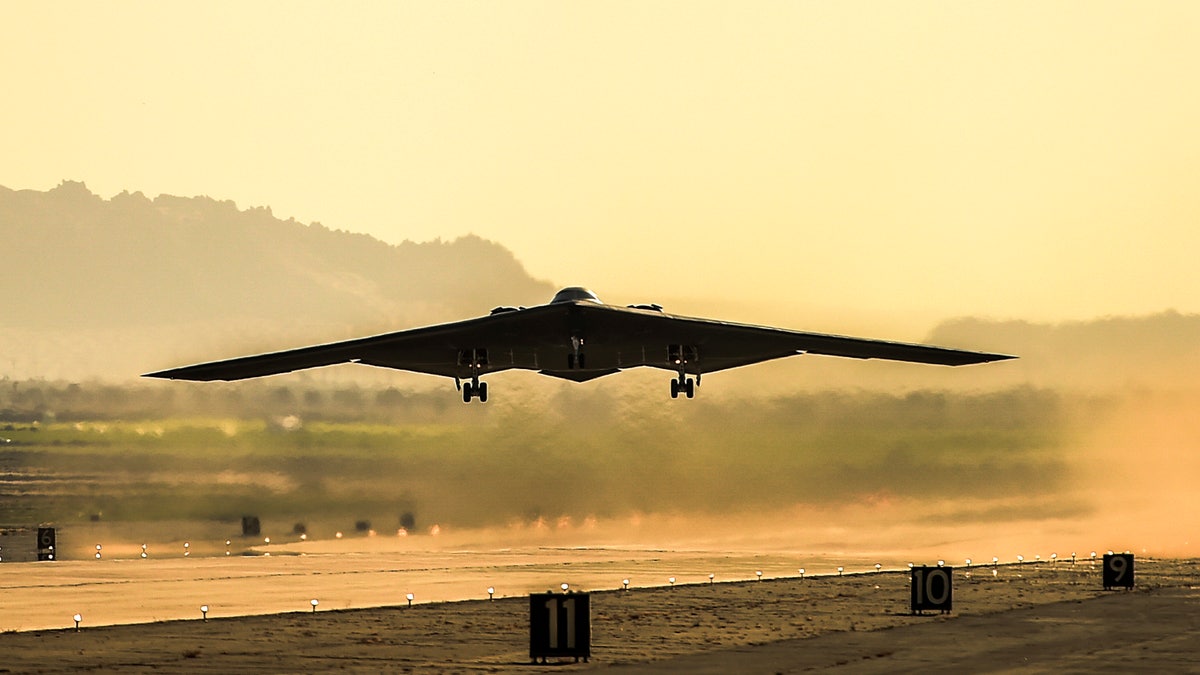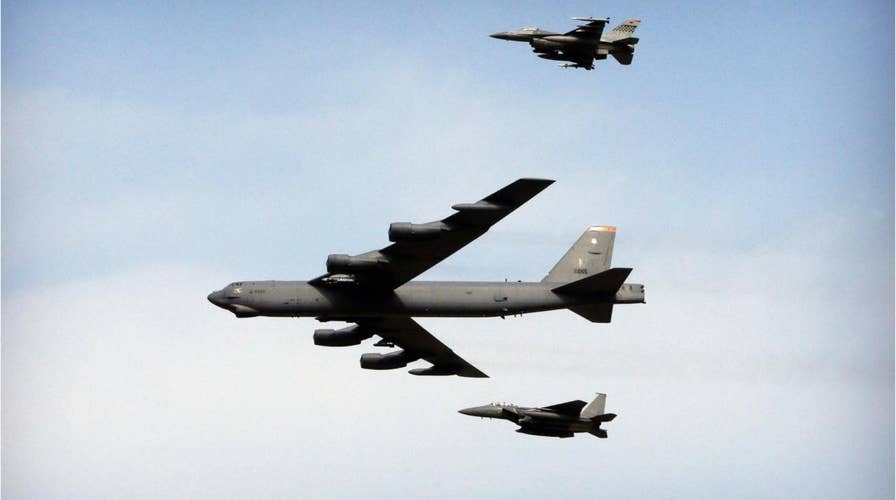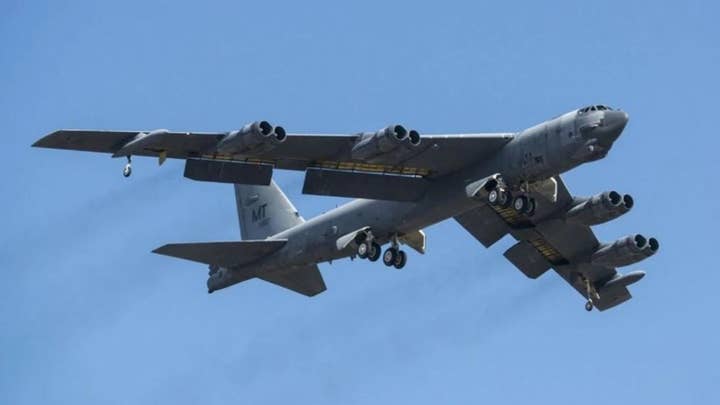B-2 bomber 30-year anniversary: Inside a B-2 stealth attack
Take a look at the stealthy B-2 bomber on it’s 30th anniversary.
Slicing through the sky with bat-like wings, eluding enemy radar with stealth technology, quietly destroying enemy air defenses from 50,000 ft and using computers to merge sensor data with targeting information -- the Air Force’s B-2 bomber … has been in the air attacking targets for “30-Years.”
“You pull up the weapons suite screen, align the right weapon with the target and provide input into the DEP - Digital Entry Panel. Then, you enter text into the computer,” Lt. Col. Nicola Polidar, Commander of Detachment 5 of the 29th Training Systems Squadron, told Warrior in an interview.
As this happens….the air attack begins.
***** The B-2 took its first flight July 17, 1989 -- so now is the “30-Year Anniversary.” ******
B-2 pilots have operated the sleek, curved air-defense-defying platform for sensitive, highly-dangerous missions many times in recent decades. After blasting onto the scene in the early 90s, the B-2s combat debut came in the late 90s when the aircraft destroyed Serbian targets over Kosovo. Three decades ago, the Air Force and Northrop Grumman thought to massively advance the paradigm for stealth attack, and create a first-of-its kind leap ahead bomber. It was conceived of as a Cold War weapon, engineered to knock out Soviet advanced air defenses. The intent was to build upon and surpass the F-117 Night Hawk’s stealth technology used in the Gulf War.
AIR FORCE SET FOR NEW NUCLEAR-ARMED MISSILE FOR 2030
The B-2s stealth configuration, buried engine, low heat signature and “radar absorbent” coating, is meant to not only avoid being hit by enemy weapons, but complete missions without enemies ever knowing it is there. Its core mission: launch secret, quiet, undetected attacks over heavily defended enemy territory to create a safer “air corridor” for less stealthy planes to operate within extremely lethal,otherwise uninhabitable airspace.
Weapons selection, navigational data and intelligence analysis are all controlled by a human pilot, operating a digital display, computer screen and fire control system in the sky.
“We have eight displays and we are able to pull up different information depending upon which buttons we push. We can see weapons, communications, flight characteristics, current atmospheric conditions, engines, electrical systems and hydraulics,” Polidar said.

Courtesy U.S. Air Force (Courtesy U.S. Air Force)
The aircraft, which entered service in the 1980s, has flown missions over Iraq, Libya and Afghanistan. Given its ability to fly as many as 6,000 nautical miles without needing to refuel, the B-2 flew from Missouri all the way to an island off the coast of India called Diego Garcia - before launching bombing missions over Afghanistan.
While the original engineering may have come from the 1980s, many upgrades, adaptations and technological improvements have sought to keep the bomber current, relevant and ahead of evolving threats.
“We’ve been through at least 10-plus major modifications, some hardware and some software. The biggest difference in flying the B-2 today is the amount of information flow coming through the cockpit,” Col Jeffery Schreiner, 509th BW Commander and B-2 Pilot, told Warrior in an interview. Schreiner has been involved with the B-2 bomber for more than 15 years.
Managing this massively increased information flow has inspired new B-2 sensors, targeting displays, communications networks and - perhaps of greatest significance - new computer automation and processor upgrades.
“Pilots manage all the different data sources to make good, tactically relevant decisions and maintain situational awareness. Now you can make specific changes and rework sorties in flight,” Schreiner said.
AIR FORCE BUILDS FIRST B-21 RAIDER 'TEST' STEALTH BOMBER
The upgrades involve the re-hosting of the flight management control processors, the brains of the airplane, onto much more capable integrated processing units. This results in the laying-in of some new fiber optic cable as opposed to the mix bus cable previously being used – because original B-2 computers from the 80s could be overloaded with data in a modern war environment, Air Force officials explained.
Schreiner’s strategic view of B-2 modernization plan aligns with what leading service thinkers envision regarding future threats and needed technical adjustments, particularly regarding this need for information and networking. One prominent Air Force strategist, Retired Lt. Gen. David Deptula, Dean of the Mitchell Institute for Aerospace Studies, describes this phenomenon in terms of the need for an emerging “combat cloud.” Improved networking technology, coupled with new processing power, enables new sensors and next-generation targeting to destroy newer threats and also maintain operations in the event that one connection is damaged in war.
“The challenge is this whole notion of sharing, and treating ships, vehicles and aircraft as information nodes. This builds robustness and redundancy of the ability to share information,” Deptula told Warrior.
Extending Deptula’s reasoning, it seems apparent that the Air Force modernization approach with the B-2 has, in some ways, managed to anticipate future warfare environments.
One such example of this is the now-in-development B-2 Defensive Management System, a new sensor enabling B-2 crews to identify some dangerous enemy locations and therefore better avert advanced air defences.
An Air Force 2018 acquisition report examines some of the technical adjustments which enable these advanced sensors, stating that the DMS “upgrades the threat warning systems on board by replacing aging antennas, electronics, display system and an autorouter.”
NAVY ARMS DESTROYERS WITH NEW HIGH-POWERED LASER
The autorouter introduces what could easily be referred to as a transformative technology for several key reasons; the report describes the autoloader as something “which automates the re-planning of aircraft missions in flight.” This brings several key implications; increased automation lessens what’s often referred to as the “cognitive burden” for pilots. This frees up pilots to focus on pressing combat variables because computer automation is performing certain key procedural functions.
Secondly, by allowing for “re-planning of aircraft missions in flight,” the autorouter brings a sizeable intelligence advantage. Instead of relying upon pre-determined target information, on-board intelligence can help pilots adjust attack missions as targets change and/or relocate.. while in flight. Much of these improvements can be attributed to an ongoing effort to implement a new computer processor into the B-2, a system reported by Air Force developers to be 1,000 times faster than the existing system.
Given their 30-year life span, many may wonder how the B-2s have been maintained and remained combat ready through the decades. B-2 maintainer 2nd Lt. Bruce Vaughn from 131st Maintenance describes it as sustaining the welding, fuselage, tubing and sheet metal. Most of all, he said, it has been crucial to maintain the low-observable components and radar absorbent material. “It involves a lot of painting and materials management. You often apply it like spray paint,” Vaughn said.

Courtesy U.S. Air Force
Vaughn’s description of the challenges and work required to maintain stealth coating, interestingly, is supported by a 2017 essay from the Robotics Institute of Carnegie Mellon University, called “Defect-Detection Technologies for Low-Observability Aircraft Skin Coatings.” The paper makes a point to emphasize the importance, and the difficulty, of maintaining stealth materials on an aircraft.
“Due to mechanical trauma, water or other chemical trauma, natural or sunlight- or temperature-accelerated chemical breakdown, etc., an aircraft's low observability coating peels off the substrate, flakes, blisters, cracks, or otherwise undergoes changes in texture or color or both,” the report states.
The essay also explores ways that both ultraviolet and infrared lights can be used to detect wear and tear or anomalies in the stealth coating. Computer algorithms, the paper explains, can also function as an integral part of the process.
Alongside the coating, there are a handful of additional key variables necessary to preserving stealth. The B-2 not only curved but also entirely horizontal, without vertical structures. This creates a scenario wherein a return electromagnetic ping, or radar signal, cannot obtain an actual rendering of the plane. The exterior is both smooth and curved, without visible seams binding portions of the fuselage. Weapons are carried internally, antennas and sensors are often built into parts of the fuselage itself so as to minimize detectable shapes on the aircraft. By not having protruding objects, shapes or certain vertical configurations such as fins, the bomber succeeds in blinding enemy radar, which is unable to generate enough returning electromagnetic “pings” to determine that an aircraft is there. An indispensable premise of B-2 sustainment is that the aircraft be prepared to succeed in the most “high-threat” or “contested” combat environments likely to exist.
The intent is to not only elude higher-frequency engagement radar, which allows air defenses to actually shoot an airplane, but also elude lower-frequency surveillance radar, which can simply detect an aircraft in the vicinity. Also, stealth aircraft such as the B-2 are built with an internal, or buried, engine to decrease the heat signature emerging from the exhaust. One goal of stealth aircraft thermal management is to try to make the aircraft itself somewhat aligned with the temperature of the surrounding air so as not to create a heat differential for enemy sensors to detect.
The priority, maintainers explain, is to ensure the weapons, electronics, computing and stealth properties are all continuously upgraded. Today’s B-2 could almost be described, in some ways, as an entirely different airplane with the same basic exterior - than it was upon first flight in 1989.
NEW AIR FORCE NUCLEAR-ARMED ICBMS TO DEPLOY BY 2029
The Air Force currently operates 20 B-2 bombers, with the majority of them based at Whiteman AFB in Missouri. The B-2 can reach altitudes of 50,000 feet and carry 40,000 pounds of payload, including both conventional and nuclear weapons.
One emerging nuclear weapon, now being tested and integrated onto the B-2 is the advanced B-61 Mod 12, an upgraded variant of several different nuclear bombs with integrates their functionality into one weapon. This not only decreases payload but of course multiplies attack options for pilots. For instance, a B-2 could quickly adjust from a point detonate variant of the B-61 Mod 12, to one designed with penetration capabilities, Air Force officials said. Alongside its nuclear arsenal, the B-2 will carry a wide range of conventional weapons to include precision-guided 2,000-pound Joint Direct Attack Munitions, or JDAMs, 5,000-pound JDAMs, Joint Standoff Weapons, Joint Air-to-Surface Standoff Missiles and GBU 28 5,000-pound bunker buster weapons, among others. The B-2 can also carry a 30,000-pound conventional bomb known as the Massive Ordnance Penetrator, a weapon described as a more explosive version of the Air Force GBU-28 bunker buster.
The platform is also preparing to integrate a long-range conventional air-to-ground standoff weapon called the JASSM-ER, for Joint Air-to-Surface Standoff Missile, Extended Range.
Despite flying more than 40-hour missions, pilots have no bed and no refrigerator, just two seats in a small cockpit and a small area behind them about the same width as the seat. Pilot’s food, Polidar said, needs to be non-perishable items.
“Sometimes we can bring a little blow-up mattress, put in on the floor and take a nap,” she said.
So how much longer will the B-2 fly? It is slated to fly alongside the emerging new B-21 Raider stealth bomber as it starts arriving in the mid 2020s, and ultimately retire. However, given its current trajectory and combat effectiveness, it seems entirely reasonable to speculate 2040? Perhaps 2050? We’ll see, the Air Force does not discuss this much.
Kris Osborn, Managing Editor of WARRIORMAVEN (CLICK HERE) can be reached at krisosborn.ko@gmail.com






















